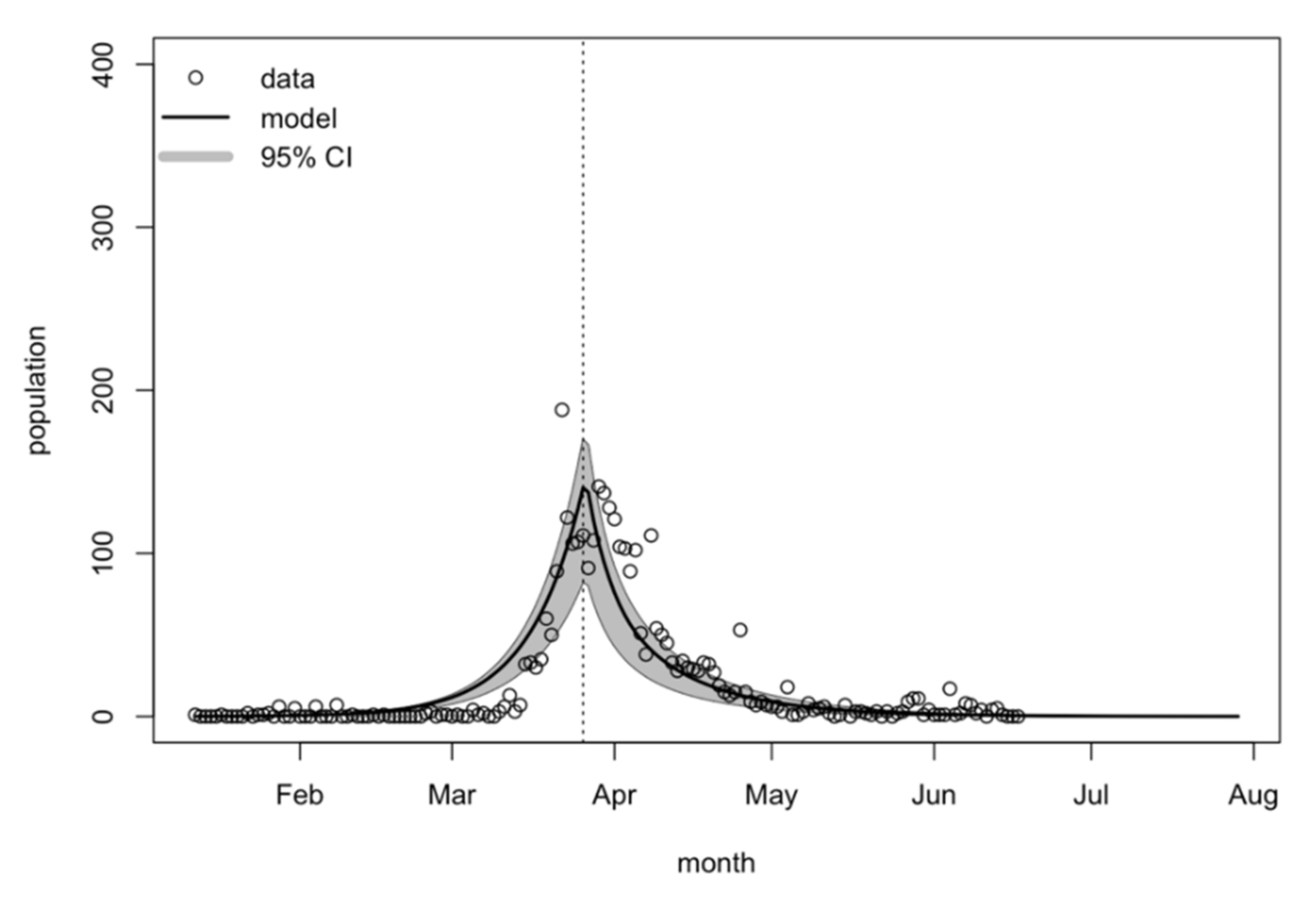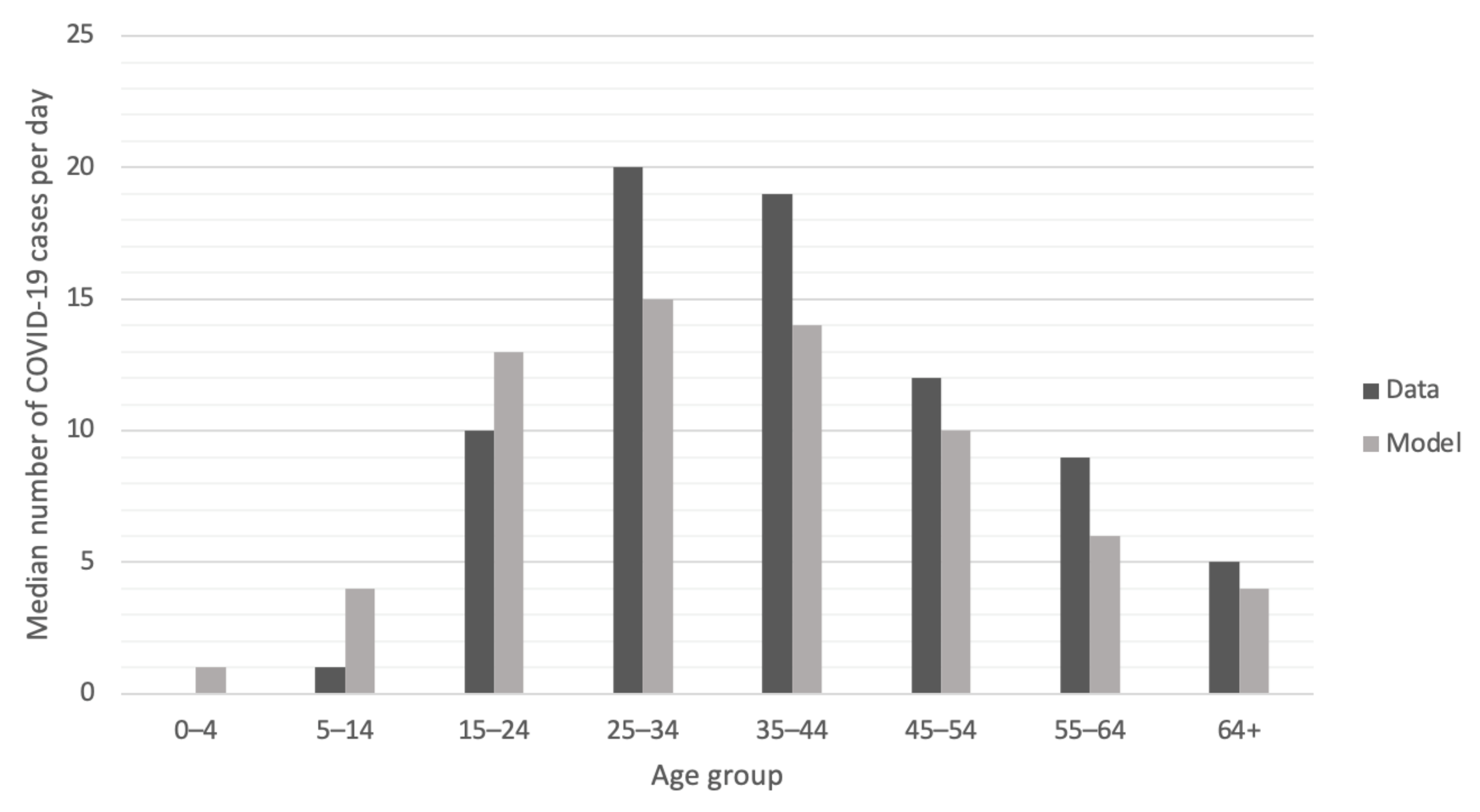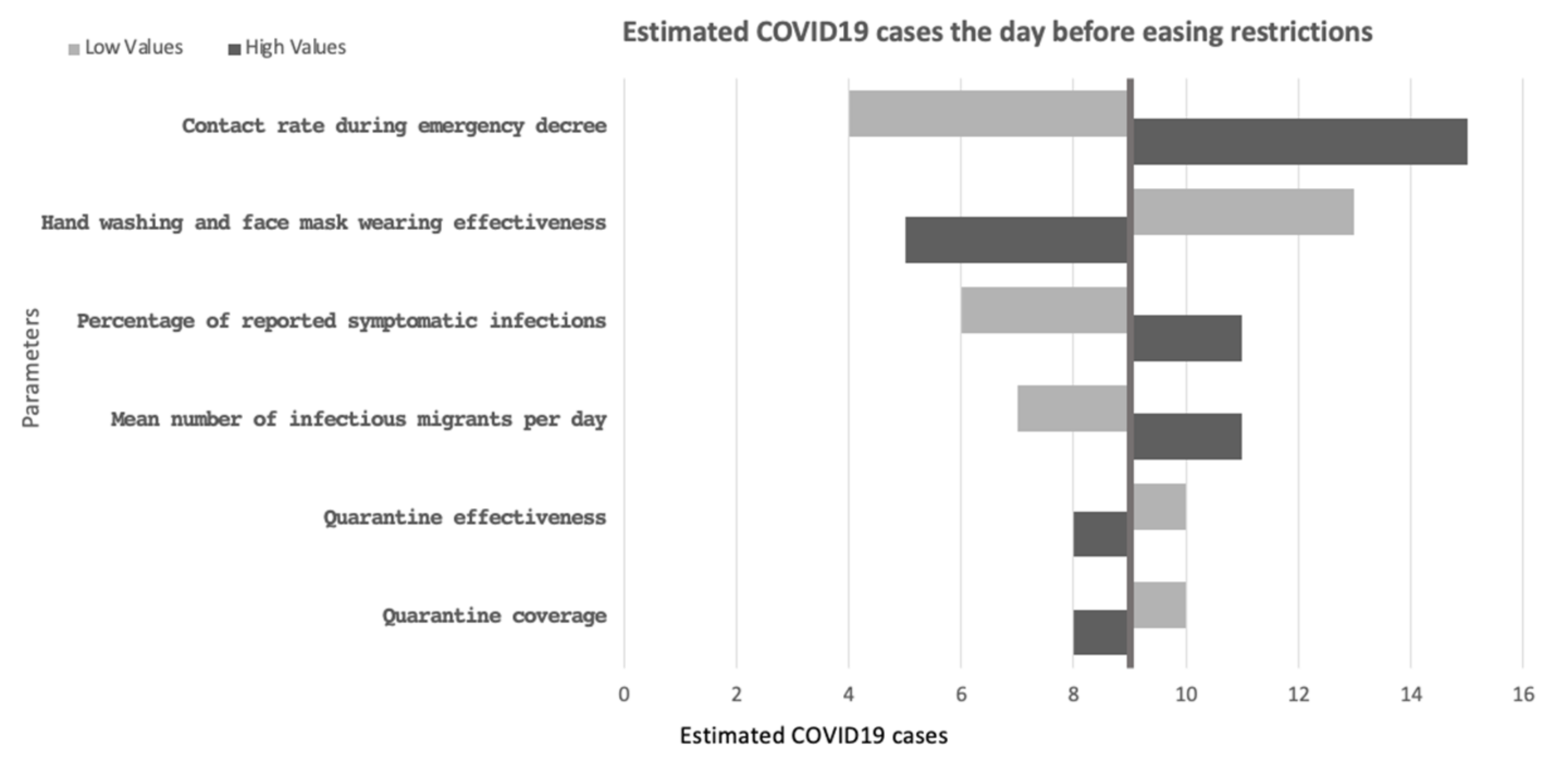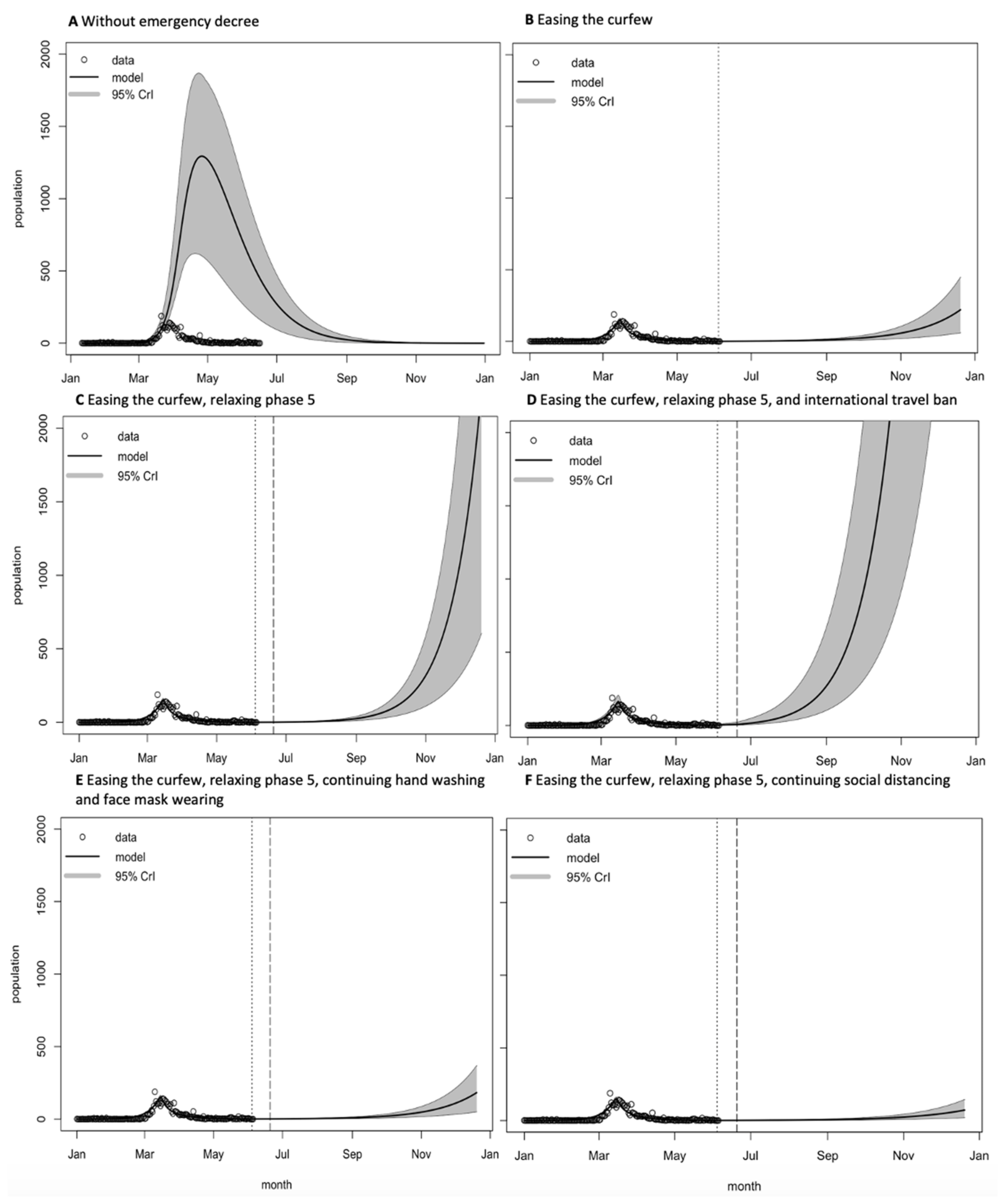Evaluating the Impact of Intervention Strategies on the First Wave and Predicting the Second Wave of COVID-19 in Thailand: A Mathematical Modeling Study
Abstract
Simple Summary
Abstract
1. Introduction
2. Materials and Methods
2.1. Model Structure
2.2. Model Simulations
2.3. Model Validation and Projection
2.4. Sensitivity Analysis
2.5. Intervention Scenarios
- A.
- The incidence of COVID-19 cases without the emergency decree (using the contact matrix of Thai setting with approximately ten contacts per day based on the contact rate from a previous study [27])
- B.
- C.
- Easing the curfew on 15 June 2020 and easing of restriction phase 5 (high-risk businesses or activities were allowed to reopen) on 1 July 2020 [10] (assuming that the contact rate among the population increased by 300% compared with the rate during the curfew periods).
- D.
- Easing the curfew on 15 June 2020, easing of restriction phase 5, and international travel ban [30] (assuming that ten infected migrants per day were taken into account when calculating the transmission rate and that the contact rate among the population increased by 300% compared with the rate during the curfew periods).
- E.
- Easing the curfew on 15 June 2020 and easing of restriction phase 5, but hand washing and face mask wearing were implemented (assuming that the transmission rate was reduced by 10% [4] after the easing of restriction phase 5).
- F.
- Easing the curfew on 15 June 2020 and easing of restriction phase 5 but the population continues to practice social distancing and work from home (assuming that the contact rate among the population reduced by 50% [31] compared with the easing of restriction phase 5).
3. Results
4. Discussion
5. Conclusions
Supplementary Materials
Author Contributions
Funding
Institutional Review Board Statement
Informed Consent Statement
Data Availability Statement
Acknowledgments
Conflicts of Interest
References
- WHO. Coronavirus Disease (COVID-19). Situation Report—209; WHO: Geneva, Switzerland, 2020. [Google Scholar]
- MoPH. Covid-19 Situation Reports; MoPH: Nonthaburi, Thailand, 2020. [Google Scholar]
- WHO Thailand. COVID-19-WHO Thailand Situation Reports [Internet], WHO Thailand Situation Report-29; WHO Thailand: Nonthaburi, Thailand, 2020. [Google Scholar]
- Chu, D.K.; Akl, E.A.; Duda, S.; Solo, K.; Yaacoub, S.; Schünemann, H.J.; Chu, D.K.; Akl, E.A.; El-harakeh, A.; Bognanni, A.; et al. Physical distancing, face masks, and eye protection to prevent person-to-person transmission of SARS-CoV-2 and COVID-19: A systematic review and meta-analysis. Lancet 2020, 395, 1973–1987. [Google Scholar] [CrossRef]
- Wong, M.C.; Huang, J.; Teoh, J.; Wong, S.H. Evaluation on different non-pharmaceutical interventions during COVID-19 pandemic: An analysis of 139 countries. J. Infect. 2020, 81, e70–e71. [Google Scholar] [CrossRef] [PubMed]
- Chowdhury, R.; Heng, K.; Shawon, M.S.R.; Goh, G.; Okonofua, D.; Ochoa-Rosales, C.; Gonzalez-Jaramillo, V.; Bhuiya, A.; Reidpath, D.; Prathapan, S.; et al. Dynamic interventions to control COVID-19 pandemic: A multivariate prediction modelling study comparing 16 worldwide countries. Eur. J. Epidemiol. 2020, 35, 389–399. [Google Scholar] [CrossRef] [PubMed]
- Doung-ngern, P.; Suphanchaimat, R.; Panjangampatthana, A.; Janekrongtham, C.; Ruampoom, D.; Daochaeng, N.; Eungkanit, N.; Pisitpayat, N.; Srisong, N.; Yasopa, O.; et al. Case-Control Study of Use of Personal Protective Measures and Risk for Severe Acute Respiratory Syndrome Coronavirus 2 Infection, Thailand. Emerg. Infect. Dis. J. 2020, 26. [Google Scholar] [CrossRef] [PubMed]
- Okada, P.; Buathong, R.; Phuygun, S.; Thanadachakul, T.; Parnmen, S.; Wongboot, W.; Waicharoen, S.; Wacharapluesadee, S.; Uttayamakul, S.; Vachiraphan, A.; et al. Early transmission patterns of coronavirus disease 2019 (COVID-19) in travellers from Wuhan to Thailand, January 2020. Euro Surveill. 2020, 25, 2000097. [Google Scholar] [CrossRef] [PubMed]
- Dechsupa, S.; Assawakosri, S.; Phakham, S.; Honsawek, S. Positive impact of lockdown on COVID-19 outbreak in Thailand. Travel Med. Infect. Dis. 2020, 36, 101802. [Google Scholar] [CrossRef] [PubMed]
- Bangkok Post. Complete End to Lockdown on July 1. Available online: https://www.bangkokpost.com/business/1925768/complete-end-to-lockdown-on-july-1 (accessed on 28 May 2020).
- Wu, J.T.; Leung, K.; Leung, G.M. Nowcasting and forecasting the potential domestic and international spread of the 2019-nCoV outbreak originating in Wuhan, China: A modelling study. Lancet 2020, 395, 689–697. [Google Scholar] [CrossRef]
- Rotejanaprasert, C.; Lawpoolsri, S.; Pan-ngum, W.; Maude, R.J. Preliminary estimation of temporal and spatiotemporal dynamic measures of COVID-19 transmission in Thailand. PLoS ONE 2020, 15, e0239645. [Google Scholar] [CrossRef]
- Wilasang, C.; Sararat, C.; Jitsuk, N.C.; Yolai, N.; Thammawijaya, P.; Auewarakul, P.; Modchang, C. Reduction in effective reproduction number of COVID-19 is higher in countries employing active case detection with prompt isolation. J. Travel Med. 2020, 27. [Google Scholar] [CrossRef]
- Prem, K.; Liu, Y.; Russell, T.W.; Kucharski, A.J.; Eggo, R.M.; Davies, N.; Flasche, S.; Clifford, S.; Pearson, C.A.B.; Munday, J.D.; et al. The effect of control strategies to reduce social mixing on outcomes of the COVID-19 epidemic in Wuhan, China: A modelling study. Lancet Public Health 2020, 5, e261–e270. [Google Scholar] [CrossRef]
- Kucharski, A.J.; Russell, T.W.; Diamond, C.; Liu, Y.; Edmunds, J.; Funk, S.; Eggo, R.M.; Sun, F.; Jit, M.; Munday, J.D.; et al. Early dynamics of transmission and control of COVID-19: A mathematical modelling study. Lancet Infect. Dis. 2020, 20, 553–558. [Google Scholar] [CrossRef]
- Aleta, A.; Martín-Corral, D.; Pastore y Piontti, A.; Ajelli, M.; Litvinova, M.; Chinazzi, M.; Dean, N.E.; Halloran, M.E.; Longini Jr, I.M.; Merler, S.; et al. Modelling the impact of testing, contact tracing and household quarantine on second waves of COVID-19. Nat. Hum. Behav. 2020. [Google Scholar] [CrossRef] [PubMed]
- Davies, N.G.; Kucharski, A.J.; Eggo, R.M.; Gimma, A.; Edmunds, W.J. Effects of non-pharmaceutical interventions on COVID-19 cases, deaths, and demand for hospital services in the UK: A modelling study. Lancet Public Health 2020, 5, e375–e385. [Google Scholar] [CrossRef]
- Walker, P.G.T.; Whittaker, C.; Watson, O.J.; Baguelin, M.; Winskill, P.; Hamlet, A.; Djafaara, B.A.; Cucunubá, Z.; Olivera Mesa, D.; Green, W.; et al. The impact of COVID-19 and strategies for mitigation and suppression in low- and middle-income countries. Science 2020, 369, 413–422. [Google Scholar] [CrossRef]
- Panovska-Griffiths, J.; Kerr, C.C.; Stuart, R.M.; Mistry, D.; Klein, D.J.; Viner, R.M.; Bonell, C. Determining the optimal strategy for reopening schools, the impact of test and trace interventions, and the risk of occurrence of a second COVID-19 epidemic wave in the UK: A modelling study. Lancet Child Adolesc. Health 2020. [Google Scholar] [CrossRef]
- Savvides, C.; Siegel, R. Asymptomatic and presymptomatic transmission of SARS-CoV-2: A systematic review. medRxiv 2020. [Google Scholar] [CrossRef]
- BORA. Official Statistic Registration Systems. Available online: https://stat.bora.dopa.go.th/stat/statnew/statMenu/newStat/home.php (accessed on 9 September 2020).
- MoPH. Public Health Statistics A.D.2018; MoPH: Nonthaburi, Thailand, 2018. [Google Scholar]
- Soetaert, K.; Petzoldt, T.; Setzer, R.W. Solving Differential Equations in R: Package deSolve. J. Stat. Softw. 2010, 33, 25. [Google Scholar] [CrossRef]
- Hartig, F.M.F.; Paul, S. BayesianTools: General-Purpose MCMC and SMC Samplers and Tools for Bayesian Statistics. Available online: https://cran.r-project.org/web/packages/BayesianTools/vignettes/BayesianTools.html (accessed on 9 September 2020).
- Gelman, A.; Rubin, D.B. Inference from Iterative Simulation Using Multiple Sequences. Stat. Sci. 1992, 7, 457–472. [Google Scholar] [CrossRef]
- Rosenthal, J.S. Optimising and Adapting the Metropolis Algorithm; Statistics in Action: Toronto, Canada, 2014. [Google Scholar]
- Meeyai, A.; Praditsitthikorn, N.; Kotirum, S.; Kulpeng, W.; Putthasri, W.; Cooper, B.S.; Teerawattananon, Y. Seasonal Influenza Vaccination for Children in Thailand: A Cost-Effectiveness Analysis. PLOS Med. 2015, 12, e1001829. [Google Scholar] [CrossRef]
- Bangkok Post. PM Agrees to Lift Night Curfew. Available online: https://www.bangkokpost.com/thailand/general/1933264/pm-agrees-to-lift-night-curfew (accessed on 12 June 2020).
- Bangkok Post. People ‘Lower Guard’ as Coronavirus Lockdown Measures Ease. Available online: https://www.bangkokpost.com/thailand/general/1919280/people-lower-guard-as-coronavirus-lockdown-measures-ease (accessed on 17 May 2020).
- Bangkok Post. Thailand to Lift Ban on International Flights Wednesday. Available online: https://www.bangkokpost.com/business/1943128/thailand-to-lift-ban-on-international-flights-wednesday (accessed on 30 June 2020).
- Ahmed, F.; Zviedrite, N.; Uzicanin, A. Effectiveness of workplace social distancing measures in reducing influenza transmission: A systematic review. BMC Public Health 2018, 18, 518. [Google Scholar] [CrossRef]
- Roda, W.C.; Varughese, M.B.; Han, D.; Li, M.Y. Why is it difficult to accurately predict the COVID-19 epidemic? Infect. Dis. Model 2020, 5, 271–281. [Google Scholar] [CrossRef] [PubMed]
- WHO. Coronavirus disease (COVID-19). Situation Report—46; 16 August 2020; WHO: Geneva, Switzerland, 2020. [Google Scholar]
- Khoshnaw, S.H.A.; Shahzad, M.; Ali, M.; Sultan, F. A quantitative and qualitative analysis of the COVID-19 pandemic model. Chaos Solitons Fractals 2020, 138, 109932. [Google Scholar] [CrossRef] [PubMed]
- MacIntyre, C.R.; Chughtai, A.A. A rapid systematic review of the efficacy of face masks and respirators against coronaviruses and other respiratory transmissible viruses for the community, healthcare workers and sick patients. Int. J. Nurs. Stud. 2020, 108, 103629. [Google Scholar] [CrossRef] [PubMed]
- Ma, Q.-X.; Shan, H.; Zhang, H.-L.; Li, G.-M.; Yang, R.-M.; Chen, J.-M. Potential utilities of mask-wearing and instant hand hygiene for fighting SARS-CoV-2. J. Med. Virol. 2020, 92, 1567–1571. [Google Scholar] [CrossRef] [PubMed]
- Chiu, N.C.; Chi, H.; Tai, Y.L.; Peng, C.C.; Tseng, C.Y.; Chen, C.C.; Tan, B.F.; Lin, C.Y. Impact of Wearing Masks, Hand Hygiene, and Social Distancing on Influenza, Enterovirus, and All-Cause Pneumonia During the Coronavirus Pandemic: Retrospective National Epidemiological Surveillance Study. J. Med. Internet Res. 2020, 22, e21257. [Google Scholar] [CrossRef]
- Mizumoto, K.; Kagaya, K.; Zarebski, A.; Chowell, G. Estimating the asymptomatic proportion of coronavirus disease 2019 (COVID-19) cases on board the Diamond Princess cruise ship, Yokohama, Japan, 2020. Euro Surveill. 2020, 25, 2000180. [Google Scholar] [CrossRef]
- Sun, T.; Weng, D. Estimating the effects of asymptomatic and imported patients on COVID-19 epidemic using mathematical modeling. J. Med. Virol. 2020. [Google Scholar] [CrossRef]
- Tantrakarnapa, K.; Bhopdhornangkul, B.; Nakhaapakorn, K. Influencing factors of COVID-19 spreading: A case study of Thailand. Z Gesundh Wiss. 2020. [Google Scholar] [CrossRef]
- Zhang, J.; Litvinova, M.; Liang, Y.; Wang, Y.; Wang, W.; Zhao, S.; Wu, Q.; Merler, S.; Viboud, C.; Vespignani, A.; et al. Changes in contact patterns shape the dynamics of the COVID-19 outbreak in China. Science 2020, 368, 1481–1486. [Google Scholar] [CrossRef]
- Ghosal, S.; Bhattacharyya, R.; Majumder, M. Impact of complete lockdown on total infection and death rates: A hierarchical cluster analysis. Diabetes Metab Syndr. 2020, 14, 707–711. [Google Scholar] [CrossRef]
- Ghanbari, B. On forecasting the spread of the COVID-19 in Iran: The second wave. Chaos Solitons Fractals 2020, 140, 110176. [Google Scholar] [CrossRef] [PubMed]
- Renardy, M.; Kirschner, D. Predicting the second wave of COVID-19 in Washtenaw County, MI. J. Theor. Biol. 2020, 110461. [Google Scholar] [CrossRef] [PubMed]
- Tantrakarnapa, K.; Bhopdhornangkul, B. Challenging the spread of COVID-19 in Thailand. One Health 2020, 100173. [Google Scholar] [CrossRef] [PubMed]





Publisher’s Note: MDPI stays neutral with regard to jurisdictional claims in published maps and institutional affiliations. |
© 2021 by the authors. Licensee MDPI, Basel, Switzerland. This article is an open access article distributed under the terms and conditions of the Creative Commons Attribution (CC BY) license (http://creativecommons.org/licenses/by/4.0/).
Share and Cite
Mahikul, W.; Chotsiri, P.; Ploddi, K.; Pan-ngum, W. Evaluating the Impact of Intervention Strategies on the First Wave and Predicting the Second Wave of COVID-19 in Thailand: A Mathematical Modeling Study. Biology 2021, 10, 80. https://doi.org/10.3390/biology10020080
Mahikul W, Chotsiri P, Ploddi K, Pan-ngum W. Evaluating the Impact of Intervention Strategies on the First Wave and Predicting the Second Wave of COVID-19 in Thailand: A Mathematical Modeling Study. Biology. 2021; 10(2):80. https://doi.org/10.3390/biology10020080
Chicago/Turabian StyleMahikul, Wiriya, Palang Chotsiri, Kritchavat Ploddi, and Wirichada Pan-ngum. 2021. "Evaluating the Impact of Intervention Strategies on the First Wave and Predicting the Second Wave of COVID-19 in Thailand: A Mathematical Modeling Study" Biology 10, no. 2: 80. https://doi.org/10.3390/biology10020080
APA StyleMahikul, W., Chotsiri, P., Ploddi, K., & Pan-ngum, W. (2021). Evaluating the Impact of Intervention Strategies on the First Wave and Predicting the Second Wave of COVID-19 in Thailand: A Mathematical Modeling Study. Biology, 10(2), 80. https://doi.org/10.3390/biology10020080







